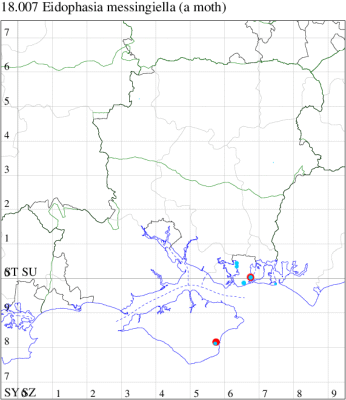2020 Annual Report for: Plutellidae / Plutellinae
For species seen in 2020 that had less than or equal to 100 records, full details are included; for more common species, the earliest, latest and highest count by vice-county are shown. The narrative for each species is taken from the main Hantsmoths website, and it is possible that some information on abundance and occurrence can get out of date, as it is impossible to keep up with all changes; however it should give a good introduction to each species. The tables in each species account summarise the previous status, and that for the current year.
For the maps, all records prior to 2020 are shown by a blue dot (the larger the dot, the more recent), with the current year's records shown in red. As previous records are superimposed on any report for 2020, new sites have greater emphasis (i.e. will show as 'more red').
In the species accounts, an asterisk next to a location indicates a new 10km square record; earliest ever dates are highlighted in orange, and latest ever in red. Initials in the species accounts refer to the recorders listed here. Please get in touch if you identify any omissions or errors, in particular if you have records that have yet to be submitted. Details of how to submit records can be found here.
18.001 [B&F: 0464] Diamond-back Moth Plutella xylostella (Linnaeus, 1758) - Migrant
Common immigrant from mainland Europe, sometimes appearing in vast numbers in all types of habitat throughout the British Isles, becoming established under favourable conditions, when occasionally reaching plague proportions on farms where cabbages are grown. Widespread and in some years abundant in Hampshire and on the Isle of Wight. Wingspan 12-17 mm. Larva feeds on various Cruciferae beneath a silken web, over-wintering as a pupa.
Records prior to 2020
| Vice County | #Records | #Individuals | First Record | Last Record |
|---|---|---|---|---|
| 10 | 930 | 7962 | 1975 | 2019 |
| 11 | 8564 | 37169 | 1971 | 2019 |
| 12 | 2014 | 8062 | 1975 | 2019 |
2020 records
| Vice County | #Records | #Individuals | Max Quantity |
|---|---|---|---|
| 10 | 54 | 139 | 41 |
| 11 | 215 | 332 | 14 |
| 12 | 53 | 74 | 6 |

Records by year
Records by week (adult)
Records by week (larval)
Record Summary
VC10: Earliest: Shanklin, 05 Apr, 1 (IOu) Latest: Shanklin, 17 Nov, 1 (IOu) Max count: Shanklin, 25 Jun, 41 (IOu)
VC11: Earliest: Fareham, 04 Apr, 1 (MLO) Latest: Southsea, 27 Nov, 1 (JRL) Max count: Portsmouth, 26 Jun, 14 (IRT)
VC12: Earliest: Yateley, 03 May, 1 (JHH) Latest: Anna Valley, Andover, 16 Nov, 2 (TJN) Max count: Anna Valley, Andover, 25 Jun, 7 (TJN)
18.003 [B&F: 0465] Plutella porrectella (Linnaeus, 1758) - Common
Common wherever the foodplant occurs, throughout the British Isles. In Hampshire the foodplant is local and so is the moth; there are only a very few records from the Isle of Wight. Wingspan 14-17 mm. Similar to Diamond-back Moth P. xylostella but slightly larger and more striated, and with three darkish rings on tip of antennae (MBGBI Vol 3). Larva feeds on Dame's-violet, beneath a silken web, often several together.
Records prior to 2020
| Vice County | #Records | #Individuals | First Record | Last Record |
|---|---|---|---|---|
| 10 | 8 | 8 | 1950 | 2017 |
| 11 | 226 | 248 | 1973 | 2019 |
| 12 | 208 | 540 | 1981 | 2019 |
2020 records
| Vice County | #Records | #Individuals | Max Quantity |
|---|---|---|---|
| 11 | 4 | 4 | 1 |
| 12 | 6 | 6 | 1 |

Records by year
Records by week (adult)
Records by week (larval)
Record Details
VC11: Romsey, one, 31 Jul (SC); Southampton, one, 31 Jul (MEdg); Winchester, one, 24 Jul (THW); Fareham, one, to actinic, 19 Sep (MLO); Pennington, one, field observation, 19 Apr (RFC);
VC12: Basingstoke, one, to actinic, 20 Jul (JHu); one, 07 May; one, 08 May; one, 09 May; one, 20 May (RHil); Yateley*, two, 21 May; one, 26 May; one, 09 Jun (JHH)
18.007 [B&F: 0469] Eidophasia messingiella (Fischer von Röslerstamm, 1840) - Local
Local on waste ground throughout much of southern England and Wales, north to Lancashire. In Hampshire, recorded very frequently on an annual basis in the Portsmouth area, with a few localised records from the 1990s in the north of the county. First recorded from the Isle of Wight in 2014 at Shanklin, where it has occurred again in recent years. Wingspan 14-16 mm. Bold cream stripe across centre of forewing and two pale rings on tip of dark antennae are characteristic of this fairly distinctive species. Larva feeds on Hoary Cress.
Records prior to 2020
| Vice County | #Records | #Individuals | First Record | Last Record |
|---|---|---|---|---|
| 10 | 1 | 2 | 2014 | 2014 |
| 11 | 197 | 484 | 1992 | 2019 |
| 12 | 3 | 3 | 1993 | 1996 |
2020 records
| Vice County | #Records | #Individuals | Max Quantity |
|---|---|---|---|
| 10 | 1 | 1 | 1 |
| 11 | 1 | 2 | 2 |

Records by year
Records by week (adult)
Records by week (larval)
Record Details
VC10: Shanklin, one, 24 Jun (IOu);
VC11: Portsmouth, two, 09 Jun (IRT)
()(report only).jpg)